This page is for the new nation Ravenspur created in May of 2016. For the circa 2007 nation of the same name, sometimes referred to as Old Ravenspur, please see Ravenspur (2007 Nation).
Ravenspur, officially the Kingdom of Ravenspur at Warszawa is a sovereign state largely located in the lands of Greater Poland on the continent of Europe. The nation originally was centered upon the capital of Czestochowa however it dissolved sometime in 2007. The nation was reestablished in 2016 with the capital in the ancient city of Warszawa following a popular uprising in that city.
|
| |||
| Ravenspur | |||
| |||
| Motto Ravenspur has not yet perished! | |||
| Capital City | Warszawa | ||
|---|---|---|---|
| Official Language(s) | English & Polish (regional) Ukrainian, Belarusian, Russian, Old Ravenspurian Slavonic, German, Lithuanian, Latvian, Hungarian, Slovak, Czech, Romanian, Latin (clerical) | ||
| Established | 5/8/2016 7:05:20 PM (reestablishment) | ||
| Government Type | |||
| Ruler | tediousandbrief | ||
| Alliance | Orange Defense Network | ||
| Nation Team | |||
| Statistics as of 22 March 2017 | |||
| Total population | 63,132 | ||
| 47,357 civilians | |||
| 15,775 soldiers | |||
| Literacy Rate | 67.00% | ||
| Religion | |||
| Currency | |||
| Infrastructure | 4,999.99 | ||
| Technology | 100.03 | ||
| Nation Strength | 20,370.842 | ||
| Nation Rank | 2,812 of 5,242 (53.64%) | ||
| Total Area | 4,348.675 miles | ||
| Native Resources | Lead, and Gold | ||
| Connected Resources | Aluminum, Coal, Iron, Lumber, Rubber, Uranium, Oil, Marble, Water and Wheat. | ||
| Bonus Resources | Steel, Beer, Automobiles, Construction, Microchips, Affluent Population, Radiation Cleanup, andAsphalt | ||
Nation Information[]
Ravenspur is a sizeable, moderately developed, and old nation at 318 days old with citizens primarily of Czech ethnicity whose religion is Taoism. Its technology is advancing rapidly. Its citizens enjoy a wealth of technology within their nation. Its citizens pay extremely high taxes and many despise their government as a result. The citizens of Ravenspur work diligently to produce Lead and Gold as tradable resources for their nation. It is a mostly neutral country when it comes to foreign affairs. It will usually only attack another nation if attacked first. Ravenspur is currently researching nuclear technology for the use of nuclear power plants but believes nuclear weapons should be banned. Plans are on the way within Ravenspur to open new rehabilitation centers across the nation and educate its citizens of the dangers of drug use. Ravenspur allows its citizens to openly protest their government, even if it means violence. It has an open border policy, but in order for immigrants to remain in the country they will have to become citizens first. Ravenspur believes in the freedom of speech and feels that it is every citizen's right to speak freely about their government. The government gives foreign aid when it can, but looks to take care of its own people first. Ravenspur will trade with other nations with questionable ethical treatment of their citizens but prefers to keep such trade agreements a secret.
Early History[]
- Main article: Ravenspur (2007 Nation)
The original Kingdom and Republic of Ravenspur was a nation which existed in the orange sphere for much of its existence in the year 2007. It is believed that due to later partitions and the eventual dissolution of the nation, much of the historical record for this nation is lost.
The main sources for this time period is from the mysterious Szarlota of Ravenspur's Chronica and Hystorie Imperium Ravenspvr. Szarlota is believed to have been a historian and author possibly coming from the Czech city of Praha who was charged with writing an account of the early life of the nation. The biography and diary of Major Anna Victoria Cross-Pym, a soldier and war hero in the Ravenspurian army around the time of the Third Great War is assumed to be genuine as well.
According to Szarlota of Ravenspur, the Kingdom of Ravenspur was founded in 2007 on February 20, 2007 at 11:23:22 PM at the city-state of Częstochowa, Poland, founded near the Jasna Góra monastery. The burgeoning nation found profit in trade and its economy was mostly in the use of gems and rubber, which quickly made it much welcome trading partner for other nations. On February 24, 2007 the nation, seeking stability of alliances, moved to the orange sphere of influence and joined the Orange Defense Network alliance. As an member of the alliance, Ravenspur benefited and grew.
The Great Third War[]
- Main article: Battle of Ravenspur
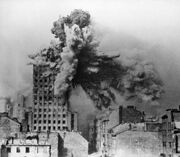
Bombing of the Old Prudential Building in Warszawa bombed during The Third Great War
On March 23, 2007, Ravenspur entered into Great War III as a member of the Orange Defense Network. Ravenspur military concentrated on the nation United Hoods of the Goon Order Of Neutral Shoving. Despite aid from the Piracy Coalition of the South Atlantic Ravenspur came under heavy attack eventually knocking the nation to under 100 infrastructure and cost the lives of 8,762 soldiers. Two of the most vicious battles took place at Warsaw (now Warszawa) and Lublin. The conflict would become known as the Battle of Ravenspur.
By the time of surrender on April 6, 2007, almost all families in Ravenspur felt the effects of the war as the population of the country dropped from around 8,000 to under 400 citizens, meaning that the nation had shrunk roughly 20 times its pre-war population. The defeat crushed the sprit of Ravenspur for quite a while.
Reconstruction and Imperial Ravenspur[]
After the massive losses due to The Great Third War, massive and much needed reconstruction went underway. With so little infrastructure left, it is presumable that the nation was helped by its allies in the Orange Defense Network to help rebuild and the chronicles do give the name of Ruler4 of the ODN Nation of Franklin as having aid to the nation as it rebuilt the country.

The Flag of Imperial Ravenspur, adopted 10 April, 2007.
At this time, two great growth spurts are mentioned in the chronicles which have survived from the time period. Known as the Great Expansion of April 10, 2007 and the May Day Expansion of May 1, 2007, the nation quickly regained territory and infrastructure lost during the war. The events were joyous occasions and the government awarded ribbons to those participants.
It was at this time that Ravenspur's borders enlarged to the point where it was considered an Empire. Imperial Ravenspur was coined upon the occasion of the two Great Expansions. Two additional medals were stamped for these occasions: the Eight Nations Medal and the Ten Nations Medal awarded on April 17, 2007 and May 1, 2007, respectfully. The awards recognized that territory from all or part of eight and later ten former nations of Eurpoe laid within Ravenspur's borders. With this influx of territory, the country's population boomed to over 50,000 citizens.
The Unjust War and Battle of Leeds[]
- Main article: Battle of Leeds
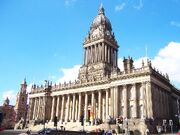
City Hall, Leeds, England, capital of the nation Bears are COOL
The nation quickly found itself back in war. With the dawn of The Unjust War, Ravenspur's military, directed by the Orange Defense Network, launched tactical raids against the nation Bears are COOL territory' concentrating efforts over the city of Leeds, England. For nine days, from the outbreak of hostilities on September 12th and 20th, 2007 what would be known as the Battle of Leeds would take place both on the ground and above the enemy city. With the help of fellow ODN allies and better training in the wake of the crippling defeat of The Great Third War, Ravenspur military the was able to declare a victory, but again at a heavy cost: records show that 48,041 soldiers and airmen were lost in the war.
The silence in the historical record as to a major loss in civilian population or infrastructure in The Unjust War as had happened in The Great Third War has been commented on by historians. It is generally assumed that the nation survived fairly well from the fighting.
End of the Chronicle and Partition[]
The historical record of Old Ravenspur after the Battle of Leeds is faint and largely unsubstantiated. Szarlota of Ravenspur's epic Chronica and Hystorie Imperium Ravenspvr from this point on gives only information taken from the October Census of Imperial Ravenspur, dated on October 7, 2007.
At that point, Ravenspur had grown substantially. The city boasted a massive 71,709 citizens with 41,709 being civilians and an army of 30,000 soldiers. Infrastructure was considered to be high at just under 4,000 (3,999.99) with a technology rating of 320 and high literacy rate of about 97%. The strength of the nation stood at 29,627.752 with the nation holding the rank in the top 30% at 2,213 of 7,792 / (28.4%).
Land area of the October Census put the country's holdings at 2,197.433 miles. While no map is included in the census, the list of cities under Ravenspur shows that the country included territory from the following Earth countries: Poland, Czech Republic, Austria, Slovakia, Belarus, Ukraine, Russia, Germany, Hungry, Lithuania, Slovenia, Croatia, Serbia, Italy, Denmark and Sweden. Ravenspur included territory as far south as Trieste and Belgrade, as far north as Malmö, and as far West as the cities of Frankfort and Hamburg.
Sometime after this, however, the nation began to flounder and dissolved in what is considered the Partition. Under the Partition, Ravenspur ceased to exist and the territory of the nation were eventually divided amongst other nations and occupying warlords and militias, sometimes with cruelty to the inhabitants.
Modern History[]
Revolution and Reestablishment[]
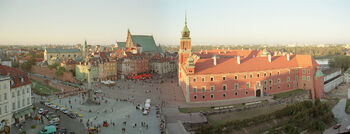
Zamek (Royal Castle) in Warszawa and Royal Castle Square; location of the Revolution and Reestablishment of Ravenspur
In the intervening years the area of Ravenspur was partitioned between a number of different rulers under different flags with much of the areas developing into separate, lesser city-states. In particular, the city-state of Warszawa had been occupied by the forces of Governor Lieutenant Colonel Vladimir Frank (often known as "Vladimir the Cruel' and "Frank the Butcher") known for his ruthlessness in exterminating political enemies and threats to his rule.
After years of oppression under foreign occupation, unhappiness and disquiet began to overtake the citizens in the city of Warszawa, a major city in the former nation of Ravenspur. A series of protests broke out throughout the city with the main protests taking place in the Old Town Market Square and the nearby Royal Castle Square. Activists called for the end of the harsh rationing of essential goods and services, an end prison without trial, reopening of the churches, and an increase in overall freedom of speech and press.
Vladimir, outraged by this small uprising, sent out his militia who quickly dispersed the protesters and arrested many of the leaders including Jerzy Wojtyła, a popular priest, formerly in the Orange Catholic Church, holding them captive in the old Royal Castle. Governor Vladimir threatened to execute the leaders of the protests within the week if protests continued and issued martial law and a harsh curfew.
The Second Miracle on the Wisła[]
The following day larger protests took hold of the city with the largest centering on the area of the Royal Castle. Protestors called now called for the release of the prisoners as well as an end to martial law, and the reinstatement of the former Ravenspur republic. When Governor Vladimir's militia opened fire on the protestors, some protestors who had taken over a nearby armory fired back on the militia, wounding Governor Frank and causing confusion within the militia ranks. Within thirty minutes of fighting breaking out, the occupying forces fled the city to the countryside. The citizens quickly declared victory and drew up the Constitution of May 8th reestablishing the nation of Ravenspur with Warszawa as its new capital city.
Uprising Spreads to the Countryside[]
It did not take long for news of the fall of Governor Vladimir Frank's forces in Warszawa and the establishment of a new Ravenspur government to spread to the countryside and nearby cities. With it came street protests as the local population longed for the rebirth of the old Imperial Ravenspur Republic. Within a days this had quickly formed in many locations to uprisings. Fearing the overwhelming groundswell of the populace, occupying forces in many other nearby major cities of Old Ravenspur quickly fled freeing many cities including Łódź, Łomza, Bialystok, Radom, and Torun; all of whose civic leaders pledged allegiance to the fledgling Warszawa government.
Word came that uprisings were taking place as far away as Brześć/Brest in Stary Białoruś (Old Belarus) and the former Old Ravenspur Capital of Jasna Gora in Czestochowa.
On May 10th, 2016 forces dispatched from the Warszawa government arrived in two decisive battlefronts on the southwestern and eastern borderlands. The previous day, after protests from the citizens, the local council Brześć/Brest in neighboring Stary Białoruś overwhelmingly voted to join the new Ravenspur. The nearby occupying warlord's forces quickly laid siege to the uprising locals.
Dispatched from Warszawa Major Aleksandra Pułaska arrived with forces to help support the uprising to free the city and was joined by friendly militia from parts of nearby Volyn’ region of Occupied Ukrainia spreading word that protests had spread to parts of that area. Once arriving at Brześć, the occupying forces were overrun by the joint forces of Major Pułaska and the joining Volyn' and local militias. By midday, with the occupying forces defeated, the area reentered Ravenspur.
On the southwestern front, Klemens Piłsudski, recently named General of the fledgling Ravenspur military due to previous fighting experience, left Warszawa traveling to the ancient city of Czestochowa in order aid local protest in the region of the historic capital of Old Ravenspur. After brief, bloodless fighting, the warlord occupying the city withdrew and the former capital complex at Jasna Gora was once again under Ravenspur control.
One Month Plans and the Capitulation of Kaliningrad[]
Throughout the rest of May 2016, Ravenspur continued growth internally as well as aiding friendly militias and protests in the surrounding borderlands. Leadership quickly began a two-pronged plan towards improving the fledgling country called One-Month-Plans. The first of these prongs was the manufacture of rare technologies for export abroad in trade for foreign aid. Technological output increased considerably. Foreign aid then was used to continue aiding the fledgling nation's infrastructure, land, and military support of pro-Ravenspur protests in the borderlands. This is facilitated through the Ravenspur Institutes of Technology.
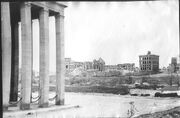
Heavy destruction left by withdrawing forces in Kaliningrad, Royal Prussia Oblast.
During this time the most significant development militarily was the Capitulation of Kaliningrad in the Royal Prussia Oblast. Having heard reports of protests having broken out around the city, Ravenspur military command dispatched only a small recognizance force headed by Lieutenant Oliwia Mazurska.
Expecting to only find only token protests, Ravenspur forces discovered that the region had been occupied by at least two major competing warlords attempting to take over the city and surrounding area with large areas of the city turned to rubble due to the fighting. The western territory was held by the forces of Otto Konigs of Brandenburg with most of the city and eastern territory held by warlord Ivanovich Kalinin, a former deputy government of Governor Vladimir Frank, former warlord of Warszawa. The resulting fighting between the two occupiers had created a virtual civil war with the city having gone through recurring name changes from Kaliningrad to Konigsberg and back again.
Originally outnumbered, Lieutenant Mazurska's forces began a low-profile infiltration of the city disguised as merchants and refugees. She quickly sent word back to the government in Warszawa. The government quickly sent additional equipment to arm the Kaliningrad protesters as well as additional partisan forces from areas of former Occupied Ukrainia ,disguised as peasants from the surrounding countryside, were dispatched to the area and placed under Mazurska's command.
Having her forces in place, Mazurska's combined forces surprised both warlords Konigs and Kalinin. After a short fight, both warlords forces evacuated the city leaving behind numerous prisoners of war and equipment. With the city left seriously damaged from the occupying armies, the remains of the local leadership quickly declared allegiance to Ravenspur, though sporadic fighting would continue in the region until the end of the month.
The Glorious Uprising[]
As word of the continued advancement of Ravenspur infrastructure and the Capitulation of Kalliningrad spread, protests throughout central and eastern Europe with citizens in foreign capitals and occupied cities taking to the streets. Protests were recorded as far as southern portions of Svensk, the city of Leipzig in the People's Republic of Saxony, and northern Romania. Most of the protesters, either impressed by the quick expansion of Ravenspur or at frustration with the local leaders and occupying petty warlords called for reincorporation of their lands and cities within the new Ravenspur. Old Earth areas to experience at least partial uprisings during this time included Sweden, Latvia, Russia (Kaliningrad Oblast), Lithuania, Ukraine, Belarus, Germany, Czech Republic, Slovakia, Austria, Hungary, Romania, a very small sliver of Moldova, and the remaining occupied portions of Poland.
By June 1, 2016, the weeks of protests erupted into a full-blown uprising through much of the region and many of the local occupying warlords evacuated as regions began to declare allegiance and fidelity to Ravenspur. The resulting expansion would see an increase of 650 infrastructure and 400 miles of land added to Ravenspur most of it peacefully. It would mark the largest single expansion in the country's history up to that point.
The "For Steve!" War / Laconia Campaign[]
- Main article: Laconia Campaign

Burned government building in Eirenopolis during the Battle of Eirene.
On June 19, 2016 the tides of war came to Ravenspur. Through their association with the Orange Defense Network, the nation found itself at war against the alliance Sparta of the black sphere of Planet Bob. Beginning the following day, June 20, the nation's military forces were involved in conflicts against multiple nations located throughout Old World globe in places as near as England and as far off as Kazakhstan. This would be the first time troops from Ravenspur would be involved in combat against another nation, rather than simply trying to liberate cities and countries such as in the Glorious Uprising.
This period would furthermore necessitate the construction of Ravesnpur's Air Corps, which the last record of existed during the Battle of Ravenspur in the Great Third War.
For Ravenspur, the war would consist of seven individual battles including some of which were primarily bombing campaigns. A total of 118,855 casualties took place during the war with three to four nuclear attacks taking place during one battle. Hundreds of miles and infrastructure was destroyed while the nation was under nuclear attack, the first time the nation had been struck by nuclear weapons either as Old/Imperial Ravenspur or modern Ravenspur.
Reconstruction[]
With the end of The "For Steve!" War, the nuclear attacks on Ravenspur left the nation crippled and in need of repairs and growth. The nation quickly came back together to rebuild. Within four months the nation had risen to nearly 5,000 infrastructure and by the end of November had expanded land territory to include Moscow. The nation also decided to begin founding national wonders with the creation of the official Stock Market, Federal Reserve, the National Research Lab, and the establishment of an Interstate System to help facilitate goods throughout the country.
In case of dilemma, a Disaster Relief Agency was founded along with a Social Security System in order to help older and less fortunate citizens.
Politics[]
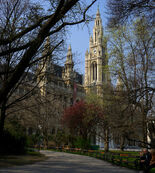
Parliment Hall
The constitution of Ravenspur is still being drafted. It is believed that the nation will have a Parliamentary government similar to either the British Parliament or the American Congress. Currently, the government is headed by temporary government headed by an executive and legislative body. Elections for the governmental positions will take place shortly. A number of political parties are now forming.
Leader's Title[]
The short title of the leader of Ravenspur is Pan, the Polish word for "sir." The formal address of title for the leader of Ravenspur is fluid as the nation grows. More titles are included as more lands end up into the nation. While this may seem comical, it is a proud marker for the nation and source of national pride.
Foreign Relations[]
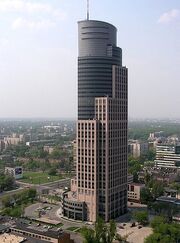
Ministry of Foreign Affairs and Trade Building, Warszawa, Ravenspur
Ravenspur originally reached out for trading partners early on in their existence. The nation is incorporating the former Ravenspur's history and has formerly laid preliminary claims on all lands formerly owned by the original Ravenspur including much of the territory Poland and Eastern and Central Europe. The nation also has issued a warrant for capture of former Governor Vladimir Frank and his forces who are still at large along with other hooligans who oppressed the people and ravaged the countryside prior to the reestablishment of the country.
Early on Ravenspur rejoined the Orange Sphere of influence and sought to rejoin the Orange Defense Network, rejoining the ODN after being waived through as a former nation of the alliance.
Embassies and Consulates[]
• Counsel Daunta Mazurski to the court of Council of Ten in the sovereign nation of the Bailiwick of Conti of the New Polar Order Alliance
• Counsel Adalbert Zieliński to the Orange Sphere
• Counsel Henryk Novak to the Orange Defense Network Alliance.
Economy[]
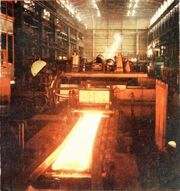
Steel production in the Piast Steel Works, Ravenspur.
Ravenspur was originally best known for its primary exports in lead and hydro industries. Bottled water from the region's Vistula River is considered among the best in the world and has been sought by countries around the world. As the nation expanded, burgeoning lumber mills produce timber for the surrounding lands, a well needed item in light of the reconstruction after years of partition and occupation. Wheat from the country's fertile countryside farms has produced an abundance of additional citizens who are well fed and a crop that is well sought after in foreign lands. Eventually lead and gold became chief exports for the country.
All the while production in factories are in high demand throughout the country, supplying goods to the many corners of the nation. Recently opened steel mills and revitalized construction companies have begun supplying the region with much needed infrastructure as the nation continues its growth.
Banks[]
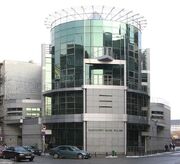
The main branch of the Ravenspur National Bank and Trust
Ravenspur's fledgling banking system has adopted the Euro as the main unit of currency. In an attempt to ward off financial difficulties various other currencies have been adopted and have been legal tender, such as the Canadian and Florien. The country is served by the main central bank, the Ravenspur National Bank & Trust, and its subsidiaries and branches located throughout the country. While locals use various currencies such as the Euro and Florin, the nation's reserve currency is the Ravenspurian Złoty.
Technology Brokerage[]
The implementation of the Ravenspur Institutes of Technology in major cities throughout the country have hastened the economy in ways that central planners only could have once upon dreamed of. Various industries create low level technologies for export. These technologies are bundled and then sold through technology brokerages to larger, foreign nations. The influx of cash helps provide additional infrastructure as well as newer technological breakthroughs.
In the short time since this policy was implemented within Ravenspur, it was quickly hailed as one of potentially the greatest advancements since before the partitions of Old Ravenspur.
Demographics[]
While Ravenspur boasts a wealth of ethnic groups, the major ethnic group is Polish. Poles permeate most areas of the countries, with sizable minorities of Ukrainians and Belarusians. Anglish immigrants from the United Kingdom and Americas feature one of the largest immigrant communities.
Languages[]
The official languages of the nation at this point are Polish and English. With the recent influx of territory from Stary Białoruś and Occupied Ukrainia, Belarusian and Ukrainian is often heard in parts of the country and has the status of minority languages. Latin is used by some clergy and clerical staff and Old Ravenspurian Slavonic can still be heard in some areas.
Since the Glorious Uprising, additional citizens with other minority languages have come within the sphere of Ravenspur's influence. These languages include Russian, Latvian, Lithuanian, German, Czech, Hungarian, Romanian, Slovak, Belarusian, Ukrainian, clerical Latin, and Old Ravenspurian Slavonic.
Major Cities in Ravenspur[]
Cities are listed with their Old Earth countries listed in parenthesis.
|
|
§: post-partition capital city
†: historic, pre-partition capital city of Old Ravenspur
‡: historic, pre-partition imperial capital of Old Ravenspur
Culture[]
The architecture of Ravenspur have fused parts from the variety of peoples who reside in the nation. Polish, Czech (Bohemian), French, and British/Anglish, are the predomenit styles of the cities. With the advent of Persian, German, and Russian immigrants inching into the nation, more of their styles are becoming evident in the nation.The average working day for a person in the nation is 37 hours per week. The culture has been categorized by some in the foreign press as a “Café Culture,” as most people take frequent breaks during the day from their jobs to sit at indoor and outdoor cafés, relax, and drink coffee. Valencia Malange, a special latte with an orange flavor is a particularly favorite drink through the country.
Religion[]
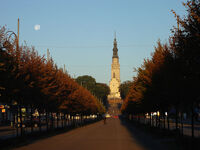
Jasna Góra monastery, Częstochowa; formerly head of the nation's church prior to occupation.
Ravenspur’s populace hold a wide mixture of religious beliefs. At the outset of the nation’s founding, the leader went followed the advice of the people, and proclaimed the national religion to be Catholic Christianity. While the people of the nation are granted the freedom to practice any faith under the Ravenspur Constitution and Declaration of Rights and Liberty, the leader holds a liberal Roman Catholic belief.
A sizable minority of the citizens follow the faith of the Orange Catholic Church and have done so in the land since the time of Old Ravenspur. With the sea of the Orange Catholic Church seemingly vacant for some time, many believers have requested a renewal of the faith and a new college of cardinals to name a new Orange Pope.
Monuments[]
- Main article: Monuments and Memorials of Ravenspur
Plans for monuments are in the works for Ravenspur. Included in this are war memorials for battles fought by the original Ravenspur nation, including one dedicated to those killed in the Great Third War as well as for those who fought on the side of Ravenspur from the nations of Piracy Coalition of the South Atlantic.
Sports[]

National Stadium of Ravenspur, Warszawa.
The nation features one main multipurpose stadium, the National Stadium in the capital of Warszawa. The main sport there is football soccer, though other athletic competitions are frequently preformed there. Field hockey is arguably the second most enjoyed sport featuring a number of leagues throughout the territory.
Anglish football came to the country originally during the period of Old Ravenspur. The sport waned in popularity under foreign occupation, but was reintroduced by American and English immigrants after the May 2016 Revolution first as a popular pastime of soldiers drill and battles.
Fencing and horseback riding are also favorite sports throughout the country. Historically schools taught both sports to children as part of the curriculum along with pistol, rifle target shooting, and archery.
Tennis, believed to have been introduced to the territory while under foreign occupation, is quickly becoming a favorite pastime.
Education[]
Ravenspur’s education is almost exclusively publicly funded due to high taxes on corporations, income, and technology exportation. Shortly after the reestablishment of Ravenspur, school were placed in nontraditional locations as many of the original schools in the area from prior to the partitioning of Ravenspur were destroyed or repurposed.
Since the Glorious Uprising, a fully implemented education system has blossomed throughout the region, featuring five school districts and two university districts.
Literature and the Arts[]
While the nation is currently building museums and institutes for the arts, the nation does not lack in a legacy of arts. Many smaller museums cities of the nations. Ravenspur, with it’s Polish nationality, holds the composer Fredrick Chopin as one it’s great cultural heroes. While musicians and artists from through the world have begun to flood into the major cities, Krakow seems to be the central location for most of these new artisans. In literature, the nation boasts Noble Laurite Henryk Adam Aleksander Pius Sienkiewicz, who’s birthday, May 5, is one of the national holidays. One of Sienkiewicz’s most famous characters, Jan Onufry Zagłoba, a jovial large knight, is a national hero (see below) and Sienkiewicz’s date of death was chosen by the legislature as the date to celebrate another national holiday, Jan Onufry Zagłoba Day.
National Holidays[]
• January 1: New Year’s Day
• February 20: National Day/Establishment Day
• April 2: National Day of Mourning (Old Ravenspur)
• April 10: The Great Expansion of Ravenspur Day (Old Ravenspur)
• Various dates: Easter Sunday
• May 1: Labour Day (May Day)
• May 3: Polish Constitution Day
• May 5: Henryk Sienkiewicz Day
• May 8: Independence Day/Reestablishment Day/Day of Revolution
• June 1: Glorious Uprising of 2016
• July 14: Bastille Day (predominately in French areas)
• September 12: Battle of Wien (King Jan III Sobieski Day)
• October 16: Karol Józef Wojtyła / Pope John Paul II Day
• November 15: Jan Onufry Zagłoba Day
• December 24-27th: Christmas Holiday
• December 31: New Years Eve
Military[]
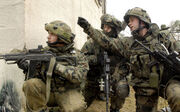
Ravenspurian military forces training.
Ravenspur's military boasts 3,925 soldiers formed in the wake of independence. Command of the military currently is headquartered in Warszawa with numerous local militias and partisan groups throughout the country side occasionally aiding in the self-defense and in uprisings around the surrounding countryside.
Total Casualties All Time[]
- Combined total military losses for both Old/Imperial Ravenspur and Modern Ravenspur:
- Old/Imperial Ravenspur: 56,803 casualties
- The Third Great War: 8,762 casualties
- The Unjust War/The Battle of Leeds: 48,041 casualties
- Modern Ravenspur: 266,951 118,855 casualties
- The "For Steve!" War: 118,855 casualties
- War for Maroon Dominance: 148,096 casualties
- Total: 323,754 casualties
- Old/Imperial Ravenspur: 56,803 casualties
Military Engagements and Losses of Ravenspur[]
Ravenspur has partaken in a total of four major wars in its history, including both the original, Old Ravenspur nation and the reestablished nation. These wars are The Third Great War and The Unjust War. Under the reestablished nation of Ravenspur, the country has participated in the wars commonly known as The "For Steve!" War against the Sparta Alliance and The War for Maroon Dominance against The Legion.
The "For Steve!" War aka Laconia Campaign (June 6, 2016 - August 25, 2016): 56,151 Attacking + 62,704 Defending = 118,855 Casualties
- The Battle of Woking: (June 20 - June 28, 2016): 7 Soldiers, 1 Tank (Attacking)
- Location: NeoWoking States - Centered at Working, England,
- The Battle of Poole: (June 24 - July 2, 2016): No Casualties Reported
- Location: Kreplakistan - Centered at Poole, England
- The Battle of Eirene: (June 24 - July 2, 2016): 27,250 Soldiers; 1,648 Tanks, 101 Aircrafts (Attacking)
- Location: Eirenopolis - Mostly in Kazakhstan and Kyrgyzstan
- The Battle Over Ifee City: (June 29 - July 7, 2016): No Casualties Reported
- Location: The Empire of Spifea - Over Southwest Missouri, near Joplin
- The Battle of the Blackstorm: (July 3 - July 11, 2016): 131 Soldiers, 73 Tanks
- Location: Blackstorm
- The Atomic Battle: (July 5 - July 13, 2016): 58,290 Soldiers, 5,926 Tanks, 66 Aircraft)
- Location: Liquidsia, Island of Sparta, The Blazing RayRex
- The Battle of the Maritimes: (July 15 - July 23, 2016): 33,177 Soldiers; 3,724 Tanks
- Location: sunny isle, over Prince Edward Island, Canada
The War for Maroon Dominance aka Bellona Campaign (March 26, 2017 - May 22, 2017): 97,250 Attacking + 50,846 Defending = 148,096 Casualties
- The Battle of Guilder: (March 26- April 3, 2017): 83,538 casualties, 8,899 tanks, 54 aircraft
- Location: Guilder - Kansas/Colorado Border
- The Battle of Sopliaci : (March 30 - April 7, 2016): 64,558 casualties, 10,647 tanks, 72 aircraft, 10 ships
- Location: Sopliaci, centered Czech Republic
Historic Military Engagements and Losses of Old Ravenspur[]
Under the original, Old Ravenspur government, Ravenspur participated in two major conflicts. Those conflicts are the Great War III from March 19, 2007 through April 7, 2007 and The Unjust War which is more commonly known in Ravenspur as The Battle of Leeds.
The Third Great War (March 19, 2007-April 7, 2007): 3,591 Attacking + 5,171 Defending = 8,762 Casualties
The Unjust War (The Battle of Leeds*) (September 9–23?, 2007): 25,246 Attacking + 22,795 Defending = 48,041 Casualties ◾The Battle of Leeds specifically lasting from September 12–20, 2007.
Total Military Losses in for Old/Imperial Ravenspur: 28,837 Attacking + 27,966 Defending = 56,803 Casualties
Current Military Honors and Awards[]
Awarded for: All participating in the Revolution and protests reestablishing Ravenspur as a new nation in the Warszawa protests.
Awarded for: Participation in the Revolutionary Expansion of May 10, 2016
Awarded for: Knighthood to the Order of the Raven and Eagle
Historic Military Honors and Awards[]
After Ravenspur's involvement in the Third Great War, the nation's government authorized military commendations and honors awarded to those individuals and nations having partaken and aided Ravenspur both during and after the Third Great War.
Awards and Medals Given During the Third Great War[]
Awarded for: Highest commendation bestowed by the people of Ravenspur, to those, in war or peacetime, who aid and contribute to the continuation and prosperity of Ravenspur.
Award Recipients:
• Sr. Lt. Václav Škoda and Cpl. Jean-Baptiste Snow (pilot and co-pilot of Ravenspur's Yakovlev Yak-9 killed in action during Third Great War)
• Maj. Anna Victoria Cross-Pym ("For special valor on multiple fronts of the Third Great War")
Awarded for: Awarded to all of those individuals partaking in the Third Great War for Ravenspur. Award Recipients: 8,700+
Awarded for: Awarded to all injured and killed soldiers of Ravenspur.
Award Recipients (en masse): 175,658+ Casualties
- Award Recipients (Old Ravenspur): 56,803+ Casualties
- Awarded Great War III: 8,762 Casualties
- Awarded Unjust War: 48,041 Casualties
- Awarded Great War III: 8,762 Casualties
- Award Recipients (Ravenspur): 118,855
Casualties
- Awarded The "For Steve!" War June War: 118,855 Casualties
- Awarded The Battle of Woking: 7 Casualties
- Awarded The Battle of Eirene: 27,250 Casualties
- Awarded The Battle of Blackstorm: 131 Casualties
- Awarded The Atomic Battle: 58,290 Casualties
- Awarded The Battle of the Maritimes: 33,177 Casualties
- Awarded The Battle of Woking: 7 Casualties
Awarded for: Special merit and valor to those members of the Piracy Coalition of the South Atlantic for helping defend Ravenspur from attacks. Award Recipients: All members of the Piracy Coalition of the South Atlantic.
Awarded for: Granted to those nations and individuals aiding Ravenspur during and after the Great Third War.
Award Recipients:
• Wonnilion and the peoples of Wonnilian Republic of the ODN, (for continued advice in times of need)
• Golan 1st and the peoples of Danieland of the ODN, (for advice and aid in times of need for the Third Great War)
• Ruler4 and the peoples of the nation of Franklin of the ODN, for aid in time of need for the Third Great War)
• pikappdave and the peoples of sirtron of the ODN, (for aid in time of need for the Third Great War).
Awarded for: Awarded to those individuals serving in the military or aiding the military from Ravenspur who serve while Ravenspur is a member of the Orange Defense Network. Award Recipients: Undetermined amount. Over 14,000.
Awarded for: Awarded to those individuals defending and aiding in the defense of Warsaw, Poland, Ravenspur. Award Recipients: Undetermined amount.
Awarded for: Awarded to those individuals defending and aiding in the defense of Lublin, Poland, Ravenspur. Award Recipients: Undetermined amount.
Awarded for: Awarded to all citizens and military members to celebrate the Great Expansion of 10 April 2007. Award Recipients: Approximately 9,000.
Awarded for: Awarded to all citizens and military members to celebrate the Expansion of Ravenspur to include territory of eight nations: Poland, Czech Republic, Austria, Slovakia, Germany, Belarus, Hungary, and Ukraine. Award Recipients: Approximately 20,000.
Awarded for: Awarded to those individuals living and serving Ravenspur during the May Day Expansion. Award Recipients: Approximately 9,000.
Awarded for: Awarded to all of those individuals living and serving Ravenspur to celebrate the nation comprising ten nations. Award Recipients: Approximately 20,000.
Foreign Awards[]
Awarded for: The people of Ravenspur were presented with and accepted the "Dark Heart" Award by the Orange Defense Network on 12 April 2007 for the nation's service during the Third Great War. In it's presentation, the medal was awarded "for undertaken operations against the GOON Alliance. successfully inflicted an irreparable amount of damage to the enemy far beyond yours even when wounded on the front."
National Symbols[]
Current Flags of Ravenspur[]

The Post-Revolution flag of Ravenspur, adopted 2016.
The current, post-revolutionary flag of Ravenspur features a three-bar flag with alternating white-red-white color pattern. The right side of the flag is decorated with traditional pattern upon the hoist. The flag is based upon the historic colors of the Kingdom and Commonwealth of Poland.
Historic Flag of Ravenspur[]

Historical Ravenspur (2007 Nation) Flag
The flag of Ravenspur originated with the official flag of Częstochowa, which can still be seen in the modern flag’s background colors of a white and blue fields separated by a yellow stripe in the middle. In the center of the flag is a twice encircled Maltese Cross (see below). The colors of the cross are white and red, imitating the flag of the nation of Poland. The circle’s inner tri-color are red, yellow, and blue. The red, again is for Poland. The yellow stands for the nations Catholic upbringing, harking back to the flag of the Vatican. The blue represents the horizon for which the nation will expand into. Four fluer-de-lys, surround the encircled Maltese Cross, in honor of the French citizens who helped build the nation. At the bottom of some flags, a stylized written of one of the nation’s mottos, Rafenspvr est imperare orbi universo. This is sometimes called the nation’s “Battle Standard” flag.
Historic Imperial Flag of Ravenspur[]

Imperial Flag of Ravenspur (April, 2007)
The Imperial Flag of Ravenspur is the common flag used to signify the entire community of Ravenspur. The flag was adopted by the legislature following the Great Expansion of April 10, 2007. The flag is also used as a flag for the Imperial Royal Family. The is a dark blue and purple nordic cross, denoting the colors of royalty. In the upper left hand corner is a series of eight small stars in a circle, one for each larger nation which Ravenspur controls some land of. More stars are expected to be added when other nations enter. In the middle of the star-circle is a Maltese cross. At the bottom left corner of the flag is the nation's name, Ravenspur.
Historic Great National Shield and Coat of Arms of Ravenspur[]
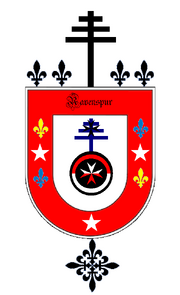
The Great Shield of Old Ravenspur as seen in "Chronica and Hystorie Imperium Ravenspvr"
The Great National Shield and Coat of Arms of Ravenspur is based around a simple red and white shield, the two national colors of Poland. The red portion is adorned with four fluer de lys in the blue and yellow colors of the Ravenspur flag. Three white stars, one at the bottom, right, and left of the shield, representing the three nations which once historically partitioned Poland (Austria-Hungary, Prussia, and Russia). At the top of the shield is the nation's name.
Located in the white center of the shield is a black orb with a red and white Maltese cross. The orb is topped by a blue papal cross with another Maltese cross over the papal cross.
The bottom of the shield has four fluer de lys affixed as a cross. The top of the shield has four additional fluer de lys and a large papal cross.
The Great National Shield and Coat of Arms is present at most state functions and is placed on most public buildings.
Official Mottos[]
Ravenspur holds a number of both official and unofficial mottos. The current main motto of the nation is "Ravenspur is not yet lost!" referencing the fact that the nation had dissolved for many years and has since been reborn into a second incarnation.
Also popular are the mottos of the former incarnation of Ravenspur. The three most popular are “Rafenspvr est imperare orbi universo," "Si Deus Nobiscum quis contra nos" (Latin: If God is with us, then who is against us?), and "'Za wolność Waszą i Naszą!" (Polish: For your and our Freedom!). The first motto is the newest motto for Ravenspur, and generally is considered the most hostile, as it’s meaning, loosely translated, is that Ravenspur will rule the universe. The second two come from the time in history when Poland was constantly fighting off occupying nations or Polish troops fought in various Democratic freedom movements, such as the American Revolution while Poland was carved up by Russia, Prussian, and Austro-Hungarian imperialists.
National Anthem[]
The nation holds many songs as patriotic songs all functioning as national anthems. These include Mazurek Dąbrowskiego, Bóg się rodzi, and "Rota" (or The Oath).
Mazurek Dąbrowskiego, (https://en.wikipedia.org/wiki/Poland_Is_Not_Yet_Lost ) was one of the national anthems of Old Ravenspur.
Bóg się rodzi (English. God is Born, https://en.wikipedia.org/wiki/God_Is_Born) ) is the ancient coronation hymn of Ravenspur as well as one of the most beloved Christmas hymns.
Rota (The Oath, https://en.wikipedia.org/wiki/Rota_(poem) ), is a hymn which grew in popularity after Old Ravenspur had been partitioned by foreign rulers. The lyrics long for the reestablishment of the nation.
Monuments[]
Plans for monuments are in the works for Ravenspur. Included in this are war memorials for battles fought by the original Ravenspur nation, including one dedicated to those killed in the Great Third War as well as for those who fought on the side of Ravenspur from the nations of Piracy Coalition of the South Atlantic.
National Heros and Legends[]
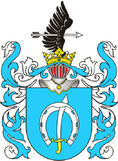
Coat of Arms of legendary hero Jan Onufry Zagłoba
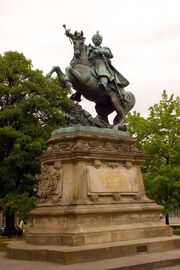
Statue of Jan III Sobieski in Gdansk.
Possibly the largest national hero is the fictitious, legendary knight Jan Onufry Zagłoba. Former Polish King Jan III Sobieski, who in the 1683 lead forces to save the Austrian city of Vienna. Ethnic Czechs in Ravenspur hold King Wenceslaus (Václav I), of the Christmas carol Good King Wenceslaus fame as a similar national hero. Various legends hold that at times of great danger to Ravenspur, these heroes will come from the mountain ranges to defend the nation from foreign invaders.
Karol Józef Wojtyła, more commonly known as Saint Pope John Paul II, has recently began being venerated among the nation’s Poles and Catholics in a similar fashion.













